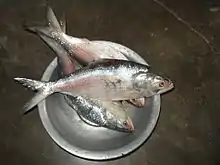Fauna of Bangladesh
The fauna of Bangladesh includes about 1,600 species of vertebrate fauna and about 1,000 species of invertebrate fauna based on incomplete records. The vertebrate fauna consists of roughly 22 species of amphibians, 708 species of fish, 126 species of reptiles, 628 species of birds and 113 species of mammals.[1] The invertebrate fauna includes about 30 species of aphids, 20 species of bees, 178 species of beetles, 135 species of flies, 400 species of spiders, 150 species of lepidopterans 52 species of decapods, 30 species of copepods, 2 species of starfish, and some species of sand dollars, sea cucumbers, and sea urchins.
| Part of a series on |
| Wildlife of Bangladesh |
|---|
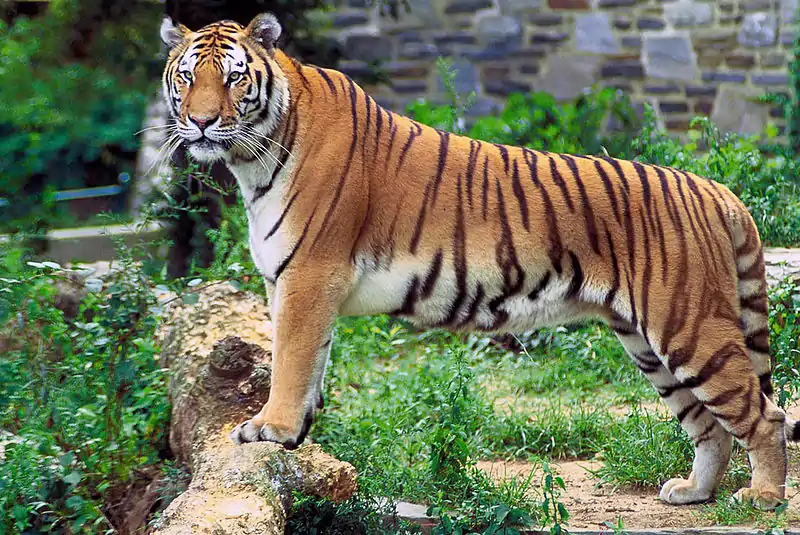 |
Bangladesh's wide variety of ecological conditions, encompassing the long sea coast, numerous rivers and their tributaries, lakes, haors, baors, ponds and other forms of wetlands, lowland evergreen forests of tropical nature, semi-evergreen forest, hill forests, moist deciduous forests, swamps, and flat lands with tall grasses, has ensured the vast diversity of species found in the country.[2][3] However, the increasing population, unplanned urbanization and expansion of agriculture and industry have been significantly affecting the ecological structure of Bangladesh, leaving several species extinct and many others endangered.[4]
Invertebrates
The invertebrate fauna so far recorded in Bangladesh comprises about 1,000 species. 18 species of bees have been discovered. Most of them are solitary bees consisting of 11 species. The rest include 4 of honeybees, 2 of bumblebees and the only stingless bee species, Trigona fuscobaltiata.[5]
There are a total of 35 species of scarab dung beetles found under 8 genera. The most common genus is Onthophagus. Another 30 species of leaf-eating scarabeids are also found. The ladybirds includes about 97 species, 80 of which are beneficial. 20 species of fireflies have also been discovered in the country.[5]
The most common indoor flies include housefly, the lesser housefly, the stable fly, the blue bottle fly, the green bottle flies and the flesh flies. The common outdoor flies include the black flies, the deer flies, the horse flies, the hover flies, the crane flies and some muscoids.[6] There are also some 113 species of mosquitos discovered in Bangladesh, the most common genera are Anopheles, Culex, Aedes, Mansonia, Psorophora and Haemagogus.[7]
More than 400 species of spiders are found under 134 genera, and 22 families. The largest family is Araneidae, consisting of some 90 species.[7]
About 124 species of butterflies have been discovered. Most of the species dwell in the northeast and southeast regions of the country.[8] There are also some species of moths, most commonly the snout moths, Scirpophaga incertulas, Chilo polychrysus, Cnaphalocrocis medinalis, Achyra nudalis, Scirpophaga nivella, Leucinodes orbonalis, Corcyra cephalonica, Plodia interpunctella and soforth.[9]
Many species of fresh and marine-water crabs, shrimps and lobsters have also been recorded in Bangladesh. 4 species of freshwater and 11 species of marine crabs have been discovered. The most commercially exploited species of the coastal area is Scylla serrata (mud crab). There are at least two species of king crabs found in the coastal zone. About 10 species of freshwater shrimp/prawns and 19 species of marine shrimps are recorded. Six species of lobsters are found to occur in the Bay of Bengal, Panulirus polyphagus and Thenus orientalis are the two most commercially important species. Daphnia is a common freshwater genus among the 20 copepod species. Two species of starfish have also been recorded.[10][11]
Vertebrates
The vertebrate fauna includes about 1,600 species. Fishes hold the largest number of species among them. Of the 708 species of fishes, 442 are marine and the rests are of fresh and brackish waters. The marine fishes are split into 18 orders and 123 families. Their species include 56 of cartilaginous fishes and 386 of bony fishes. The 266 species of inland fishes belong to 61 families, of which Cyprinidae is the largest, having 61 species. There are also 55 species of catfishes found in the fresh waters of Bangladesh.[13][14]
The amphibians in Bangladesh include only the species of the order Anura. From the 22 amphibian species, 8 are recognized as threatened.[14] The number of reptiles species found is 126 which includes 109 inland and 17 marine species. From the 109 inland reptiles, 2 are crocodilians, 21 turtles and tortoises, 18 lizards, and 67 snakes. The marine reptiles comprise 12 snakes and 5 turtles.[15]
There are 628 species of birds found in Bangladesh under 16 orders and 67 families, including 276 passerines. Resident species total 388 (including 171 passerines) under 16 orders and 60 families, while the remaining 240 species (including 105 passerines) under 10 orders and 33 families are migratory.[16] The mammals of Bangladesh comprise 110 species of inland mammals under 12 orders and 35 families, and three species of marine mammals only from the order Cetacea.[17]
Conservation efforts
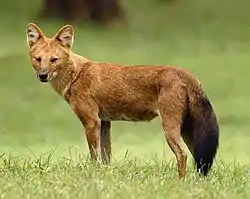
So far a number of creatures have disappeared completely from the country and a further 201 species are threatened. The dhole, also called the Asiatic wild dog, is now endangered by habitat and prey-species loss and human persecution. Notable animal species that have disappeared from Bangladesh are the greater one-horned rhinoceros, the Asian two-horned rhinoceros, the gaur, the banteng, swamp deer, nilgai, Indian wolf, wild water buffalo, marsh crocodile and common peafowl.[1] The majority of the human population lives in or around large cities, and this has helped to limit deforestation to some extent. However, the growth rate continues to increase and this has placed large demands on the environment and lead to subsequent clearing of numerous natural habitats. Though several areas are protected under law, a large portion of Bangladeshi wildlife is threatened by this growth.
In 2016, conservationists surveying the rural Chittagong Hill Tracts region of Bangladesh took the country's first ever photos of the sun bear and gaur. Moreover, the team also captured photos of the Himalayan serow, Asian golden cat, sambar deer, barking deer, leopard cat and dhole. Locals in the Chittagong Hill Tracts led conservationists to a new population of Arakan forest turtle. Once thought extinct, the critically endangered species was assumed only to survive in neighbouring Myanmar.[18]
Olive ridley sea turtles nest on the shores of Bangladesh, where they are threatened by marine plastic pollution.[19]
Gallery
 The Bengal tiger is the national symbol of Bangladesh
The Bengal tiger is the national symbol of Bangladesh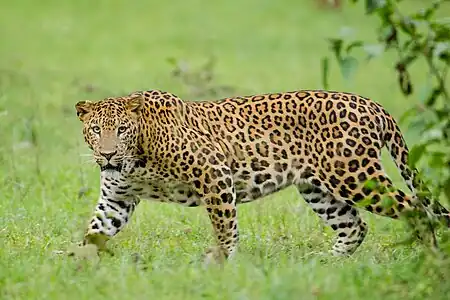 Indian leopards can be found in the Chittagong Hill Tracts of Bangladesh
Indian leopards can be found in the Chittagong Hill Tracts of Bangladesh Wild Indian elephants can be seen in hilly areas of Bangladesh
Wild Indian elephants can be seen in hilly areas of Bangladesh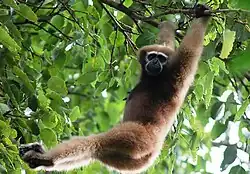 Hoolock gibbon in Bangladesh
Hoolock gibbon in Bangladesh.jpg.webp) The saltwater crocodile is the largest of all living reptiles
The saltwater crocodile is the largest of all living reptiles_male.jpg.webp) Chital deer are widely seen in Sundarbans and other mangrove forests
Chital deer are widely seen in Sundarbans and other mangrove forests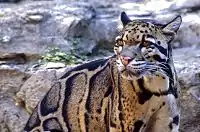 Clouded leopards can be found in the southeastern part
Clouded leopards can be found in the southeastern part Python reticulatus is the world's longest snake and longest reptile
Python reticulatus is the world's longest snake and longest reptile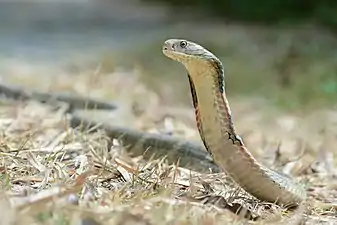

.jpg.webp)
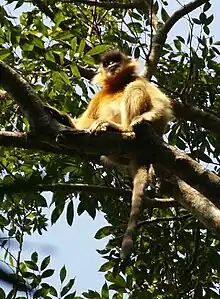

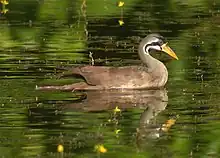 Masked finfoot, a beautiful bird found in mangrove forests.
Masked finfoot, a beautiful bird found in mangrove forests.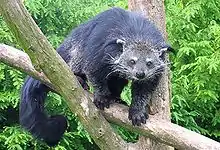
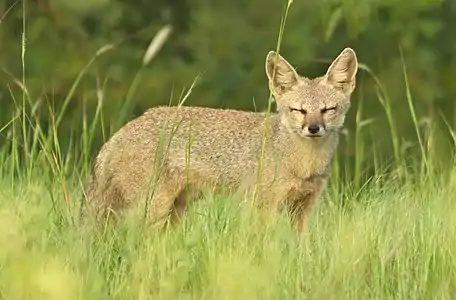

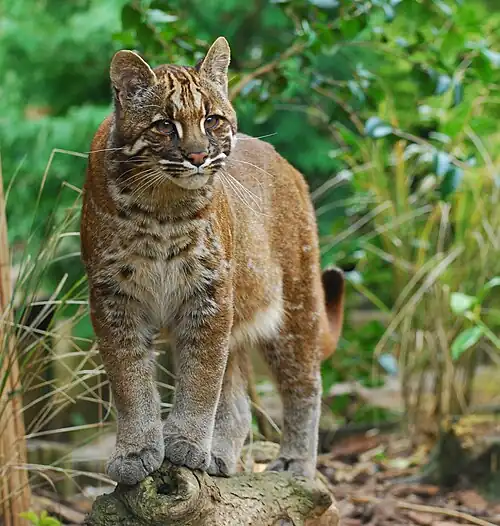
 Sun bears can be found in the Chittagong Hill Tracts
Sun bears can be found in the Chittagong Hill Tracts_at_Nagarahole_wildlife_sanctuary.jpg.webp) The gaur the largest extant bovine, is native to parts of South Asia and most of Southeast Asia.
The gaur the largest extant bovine, is native to parts of South Asia and most of Southeast Asia.
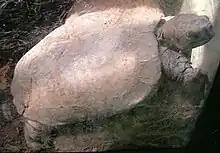
.JPG.webp)
 Dolphins in Al Bandar bay
Dolphins in Al Bandar bay
See also
References
- Khan, M. Monirul H. (2008). Protected Areas of Bangladesh - A Guide to Wildlife. Dhaka, Bangladesh: Nishorgo Program, Bangladesh Forest Department. OCLC 795008978.
- Bio-ecological Zones of Bangladesh. IUCN. 2002. ISBN 9843110900.
- Chowdhury, Quamrul Islam (2001). Bangladesh, State of Bio-diversity. Cornell University. ISBN 9847560129.
- Razzaque, Jona (2004). Public interest environmental litigation in India, Pakistan, and Bangladesh. Kluwer Law International. ISBN 9041122141.
- Islam, Md Nurul (2012). "Bee". In Islam, Sirajul; Jamal, Ahmed A. (eds.). Banglapedia: National Encyclopedia of Bangladesh (Second ed.). Asiatic Society of Bangladesh.
- Molla, Md Abdus Sattar (2012). "Fly". In Islam, Sirajul; Jamal, Ahmed A. (eds.). Banglapedia: National Encyclopedia of Bangladesh (Second ed.). Asiatic Society of Bangladesh.
- Huda, KM Nurul (2012). "Mosquito". In Islam, Sirajul; Jamal, Ahmed A. (eds.). Banglapedia: National Encyclopedia of Bangladesh (Second ed.). Asiatic Society of Bangladesh.
- Ahmad, Monawar (2012). "Butterfly". In Islam, Sirajul; Jamal, Ahmed A. (eds.). Banglapedia: National Encyclopedia of Bangladesh (Second ed.). Asiatic Society of Bangladesh.
- Ahmad, Monawar (2012). "Moth". In Islam, Sirajul; Jamal, Ahmed A. (eds.). Banglapedia: National Encyclopedia of Bangladesh (Second ed.). Asiatic Society of Bangladesh.
- Islam, M. Rafiqul (2004). Where land meets the sea: a profile of the coastal zone of Bangladesh. University of California. ISBN 9840517198.
- Kabir, SM Humayun (2012). "Fauna". In Islam, Sirajul; Jamal, Ahmed A. (eds.). Banglapedia: National Encyclopedia of Bangladesh (Second ed.). Asiatic Society of Bangladesh.
- Kabir, SM Humayun (2012). "Hilsa". In Islam, Sirajul; Jamal, Ahmed A. (eds.). Banglapedia: National Encyclopedia of Bangladesh (Second ed.). Asiatic Society of Bangladesh.
- Sultana, P.; Thompson, P.; Ahmed, M. Understanding livelihoods dependent on inland fisheries in Bangladesh and Southeast Asia: final technical report. The WorldFish Center.
- Chakraborty, Subhash Chandra (2012). "Fish". In Islam, Sirajul; Jamal, Ahmed A. (eds.). Banglapedia: National Encyclopedia of Bangladesh (Second ed.). Asiatic Society of Bangladesh.
- Islam, Md Anwarul (2012). "Reptile". In Islam, Sirajul; Jamal, Ahmed A. (eds.). Banglapedia: National Encyclopedia of Bangladesh (Second ed.). Asiatic Society of Bangladesh.
- Islam, Md Anwarul (2012). "Bird". In Islam, Sirajul; Jamal, Ahmed A. (eds.). Banglapedia: National Encyclopedia of Bangladesh (Second ed.). Asiatic Society of Bangladesh.
- Islam, Md Anwarul (2012). "Mammal". In Islam, Sirajul; Jamal, Ahmed A. (eds.). Banglapedia: National Encyclopedia of Bangladesh (Second ed.). Asiatic Society of Bangladesh.
- Hance, Jeremy (1 March 2016). "Tiger country? Scientists uncover wild surprises in tribal Bangladesh". The Guardian. ISSN 0261-3077. Retrieved 13 May 2017.
- "Race to rescue turtles entangled in plastic on Bangladesh beach". Aljazeera. 13 July 2020. Retrieved 28 July 2020.
- Mehrtens, John (1987). Living Snakes of the World. New York: Sterling. ISBN 0-8069-6461-8.
- Wood, Gerald (1983). The Guinness Book of Animal Facts and Feats. ISBN 978-0-85112-235-9.
